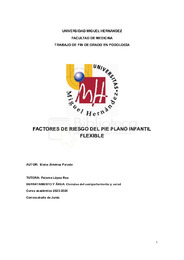Por favor, use este identificador para citar o enlazar este ítem:
https://hdl.handle.net/11000/33293Registro completo de metadatos
| Campo DC | Valor | Lengua/Idioma |
|---|---|---|
| dc.contributor.advisor | López Ros, Paloma | - |
| dc.contributor.author | Jiménez Parada, Elena | - |
| dc.contributor.other | Departamentos de la UMH::Ciencias del Comportamiento y salud | es_ES |
| dc.date.accessioned | 2024-09-25T11:44:05Z | - |
| dc.date.available | 2024-09-25T11:44:05Z | - |
| dc.date.created | 2024-06-01 | - |
| dc.identifier.uri | https://hdl.handle.net/11000/33293 | - |
| dc.description.abstract | El pie plano infantil flexible es una condición en la que se pierde el arco longitudinal interno del pie y se presenta una deformidad en valgo del retropié, afectando al 95% de los niños de manera fisiológica. Este tipo de pie plano recupera su forma normal cuando no está en carga, a diferencia del pie plano valgo rígido. Las causas pueden incluir desequilibrio de fuerzas musculares, la forma y fuerza de las estructuras óseo-ligamentosas, y la alineación rotacional del miembro. En niños hasta los 3-4 años, el pie plano es común y generalmente se resuelve con el crecimiento. Entre los 4-10 años, la prevalencia del pie plano flexible es del 44% y disminuye con la edad. A partir de los 10 años, el 6% de los niños aún presenta esta deformidad. Factores de riesgo como hiperlaxitud, torsión tibial externa, anteversión femoral, índice de masa corporal (IMC) elevado, acortamiento de la musculatura posterior, antecedentes familiares, e insuficiencia del tibial posterior pueden impedir la corrección natural del pie plano. El estudio descriptivo transversal realizado en el Colegio Fabraquer del Campello involucró a 400 niños y niñas de 3 a 12 años, con una participación equilibrada entre ambos sexos. Se llevó a cabo durante el mes de enero de 2024. Se incluyeron mediciones físicas como peso, altura e índice de masa corporal, junto con pruebas clínicas en carga y descarga, incluyendo evaluaciones de hiperlaxitud articular, rotación de cadera, flexión dorsal (FD) del tobillo y test de Bleck para metatarsus adductus. Los datos fueron registrados en la base de datos "Shymphytum" y analizados utilizando el programa "Jamovi", con criterios de normalidad establecidos según la bibliografía existente. De la muestra total de niños y niñas pertenecientes al estudio 182 eran niñas y 196 niños. Los resultados de mayor a menor prevalencia muestran un IMC elevado con un porcentaje de un 62.5% en niñas y niños, seguido de rotación interna y externa de cadera con un mayor porcentaje de disminuida que de aumentada, siguiendo el orden con la FD de la TPA tanto con rodilla extendida como flexionada. Por último, en cuanto a metatarsus adductus un 6.52% presentaban esta patología y la hiperlaxitud tuvo un valor de 6.4%. Dado que todos estos factores tienen una alta relación con el adulto, deben tratarse estos factores de riesgo para que no evolucionen con la edad y puedan llegar a producir patologías relacionadas con estos en edad adulta. | es_ES |
| dc.description.abstract | Infantile flexible flatfoot is a condition in which the internal longitudinal arch of the foot is lost and a valgus deformity of the hindfoot is present, affecting 95% of children physiologically. This type of flatfoot recovers its normal shape when unloaded, unlike rigid valgus flatfoot. Causes may include imbalance of muscle forces, the shape and strength of the bony-ligamentous structures, and rotational alignment of the limb. In children up to 3-4 years of age, flatfoot is common and usually resolves with growth. Between the ages of 4-10 years, the prevalence of flexible flatfoot is 44% and decreases with age. After the age of 10 years, 6% of children still have this deformity. Risk factors such as hyperlaxity, external tibial torsion, femoral anteversion, high body mass index (BMI), shortening of the posterior musculature, family history, and posterior tibial insufficiency may prevent natural correction of flatfoot. The cross-sectional descriptive study carried out at the Fabraquer del Campello School involved 400 boys and girls aged 3 to 12 years, with a balanced participation of both sexes. It was carried out during the month of January 2024. Physical measurements such as weight, height and body mass index were included, along with clinical tests in loading and unloading, including assessments of joint hyperlaxity, hip rotation, dorsal flexion (DF) of the ankle and Bleck's test for metatarsus adductus. The data were recorded in the “Shymphytum” database and analyzed using the “Jamovi” program, with normality criteria established according to the existing literature. Of the total sample of children belonging to the study, 182 were girls and 196 were boys. The results from highest to lowest prevalence show an elevated BMI with a percentage of 62.5% in girls and boys, followed by internal and external rotation of the hip with a higher percentage of decreased than increased, following the order with the FD of the TPA both with extended and flexed knee. Finally, regarding metatarsus adductus, 6.52% presented this pathology and hyperlaxity had a value of 6.4%. Given that all these factors are highly related to the adult, these risk factors should be treated so that they do not evolve with age and may produce pathologies related to them in adulthood. | es_ES |
| dc.format | application/pdf | es_ES |
| dc.format.extent | 30 | es_ES |
| dc.language.iso | spa | es_ES |
| dc.publisher | Universidad Miguel Hernández | es_ES |
| dc.rights | info:eu-repo/semantics/openAccess | es_ES |
| dc.rights | Attribution-NonCommercial-NoDerivatives 4.0 Internacional | * |
| dc.rights.uri | http://creativecommons.org/licenses/by-nc-nd/4.0/ | * |
| dc.subject | pie plano infantil flexible | es_ES |
| dc.subject | factores de riesgo | es_ES |
| dc.subject | mediciones físicas | es_ES |
| dc.subject.other | CDU::6 - Ciencias aplicadas | es_ES |
| dc.title | Factores de riesgo del pie plano infantil flexible | es_ES |
| dc.type | info:eu-repo/semantics/bachelorThesis | es_ES |

Ver/Abrir:
TFG Elena Jiménez Parada .pdf
834,66 kB
Adobe PDF
Compartir:
 La licencia se describe como: Atribución-NonComercial-NoDerivada 4.0 Internacional.
La licencia se describe como: Atribución-NonComercial-NoDerivada 4.0 Internacional.
.png)